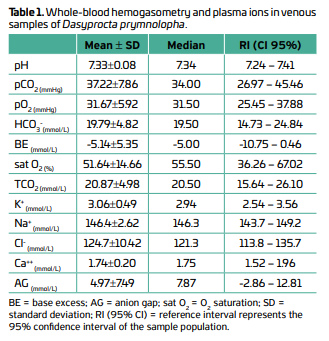Electrolytic and hemogasometric parameters for female agoutis (Dasyprocta prymnolopha Wagler, 1831) raised in captivity
DOI:
https://doi.org/10.21708/avb.2022.16.1.10301Resumo
Agoutis (Dasyprocta prymnolopha, WAGLER 1831) have been studied in captivity as a potential source of meat for rural populations in Brazil, as a way of providing low-cost protein and easing hunting pressures in local communities. However, little is known about their physiological blood markers, which are crucial for animal husbandry and effective welfare management. This study provides hemogasometric and ionic venous parameters for female agoutis raised in captivity in the drylands of Brazil. Venous blood samples were collected from six females and analyzed for dissolved gases and ions in the blood. Hemogasometric parameters, especially base excess and anion gap were generally heterogenous, while ions varied little among individuals. Moreover, we observed high chlorine values and negative base excess values, which suggest that some animals might be implementing compensatory mechanisms for ion imbalances. We provide a preliminary note on agouti venous gases and ions, while reiterating the importance of the clinical context and in-house parameter definition to maximize accuracy.
Downloads

Downloads
Publicado
Edição
Seção
Licença
Autores que publicam na Acta Veterinaria Brasilica concordam com os seguintes termos: a) Autores mantém os direitos autorais e concedem à revista o direito de primeira publicação, com o trabalho simultaneamente licenciado sob a Licença Creative Commons Attribution que permite o compartilhamento do trabalho com reconhecimento da autoria e publicação inicial nesta revista. b) Autores têm autorização para assumir contratos adicionais separadamente, para distribuição não-exclusiva da versão do trabalho publicada nesta revista (ex.: publicar em repositório institucional ou como capítulo de livro), com reconhecimento de autoria e publicação inicial nesta revista. c) Autores têm permissão e são estimulados a publicar e distribuir seu trabalho online (ex.: em repositórios institucionais ou na sua página pessoal) a qualquer ponto antes ou durante o processo editorial, já que isso pode gerar alterações produtivas, bem como aumentar o impacto e a citação do trabalho publicado (Veja O Efeito do Acesso Livre).


 Esta obra está licenciada com uma Licença
Esta obra está licenciada com uma Licença 